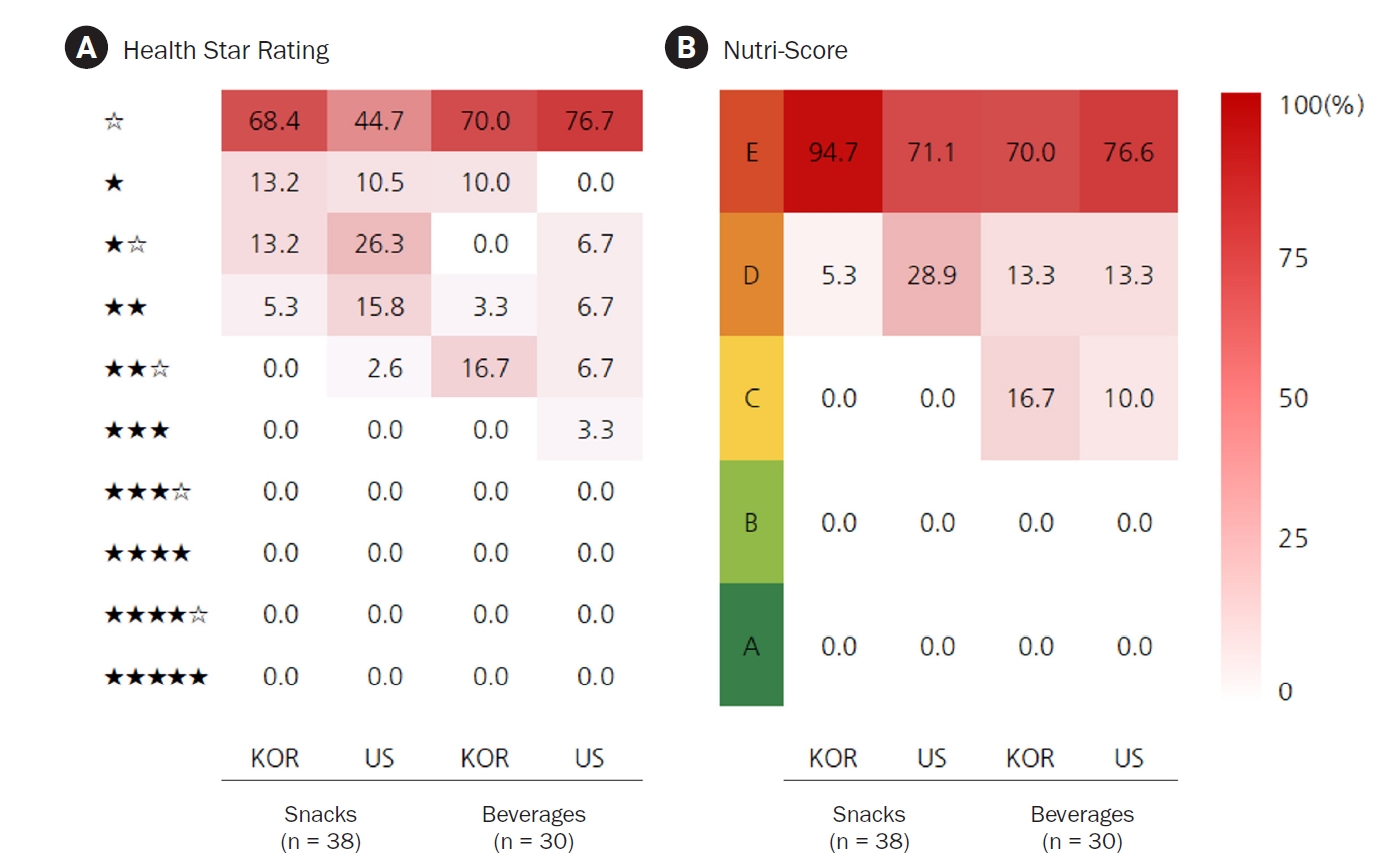Search
- Page Path
- HOME > Search
Research Article
- [English]
- Nutritional content and healthiness in sweet and salty snacks and beverages popular in South Korea and the United States assessed by nutrition labels: a cross-sectional comparative study
- Bo Jeong Gong, Segovia Lucas, Diewo Camara, Pauline E. Jolly, Chandrika Piyathilake, Taisun Hyun
- Korean J Community Nutr 2024;29(6):467-479. Published online December 31, 2024
- DOI: https://doi.org/10.5720/kjcn.2024.00290

-
 Abstract
Abstract
 PDF
PDF - Objectives
This study investigated the nutritional differences between sweet and salty snacks and beverages in South Korea (Korea) and the United States (US). Nutritional content and healthiness were determined using back- and front-of-package nutrition labeling (FoPNL) systems.
Methods
Three snack and three beverage categories popular in Korea and the US were selected. Statistical data were used to determine the top 10–15 best-selling products in each category in each country. The selected products included chips (n = 15), cookies (n = 10), chocolate (n = 13), carbonated drinks (n = 10), fruit juices/drinks (n = 10, 5/5), and energy drinks (n = 10). The study excluded products that were artificially sweetened. Nutritional information and percentages of fruit and vegetable content in each product were collected from brand websites and grocery stores in each country. The FoPNL system was used to assess the healthiness of the products, which included multiple traffic light labels, a Health Star Rating, and a Nutri-Score.
Results
Overall, Korean snacks contained significantly more protein, total fat, saturated fat, and cholesterol than US snacks. However, the US chips and carbonated drinks contained more sodium, while the US energy drinks contained more caffeine than Korean products. The serving size of US carbonated drinks was significantly larger than that of Korean drinks, whereas the serving size of US chips was smaller than that of Korean products. The FoPNL system classified the majority of products as ‘less healthy.’
Conclusion
Our results suggest that Korean and US food manufacturers should improve the nutritional quality and/or serving size of commonly consumed food products. Policymakers in both countries should work to improve the presentation of ingredient and nutrient information on nutritional labels to assist consumers in making healthier food choices.
- 5,720 View
- 53 Download

Original Article
- [English]
- Revision of the Target Pattern based on Single Serving Size of Dishes for Korean Adolescent Meal Plan
- Mi Jin Park, Youngnam Kim
- Korean J Community Nutr 2015;20(1):21-29. Published online February 28, 2015
- DOI: https://doi.org/10.5720/kjcn.2015.20.1.21
-
 Abstract
Abstract
 PDF
PDF - OBJECTIVES
Maintaining a balanced diet is very crucial for adolescents. However, adolescents, who may have a short notion about the amount of food, find it difficult to plan daily meals by applying the target pattern proposed by the Korean Nutrition Society. This study was carried out to revise the target pattern based on cooked dishes instead of raw material food groups as an easier way for Korean adolescents to plan their meals.
METHODS
Target pattern for Korean adolescents were revised based on the following: 1st, categorize dish groups, 2nd, calculate representative values of each dish based on the adolescent' intake amount. 3rd, assign the recommended number of intake for each dish. Validity of the target pattern for Korean adolescent meal plan was examined by the energy content, energy contribution ratio, and NAR & INQ of nutrients.
RESULTS
The 11 dish groups categorized were bab; gook.tang.gigae; side dishes of meat, fish, egg, legume, kimchi, vegetable, seaweed; and between meal of fruit, and milk.dairy product. Based on the representative energy values, recommended number of intake were assigned to each dish. For boys, bab and gook.tang.gigae: 3 each; meat, fish, egg, and legume: 1 each; kimchi and vegetable: 3 each; seaweed: 1; fruit and milk.dairy product: 2 each were assigned. For girls, bab and gook.tang.gigae: 2 each; meat, fish, egg, and legume: choice of 3 dishes, 1 each; kimchi and vegetable: 3 each; seaweed: 1; fruit and milk.dairy product: 2 each were assigned. Energy contents, energy contribution ratio of carbohydrate, protein, and fat for boys and girls were in adequate range. The NARs were 1.0 and INQs were > or = 1.0 for all nutrients examined.
CONCLUSIONS
Revised dish-based, instead of food-based adolescent target patterns for boys and girls were easier and a valid way of Korean adolescent meal planning. -
Citations
Citations to this article as recorded by- Representative Nutrients Contents and Nutritional Adequacy Evaluation of Single-Dish Meal for Middle School Students
Gisun Lee, Youngnam Kim
Korean Journal of Community Nutrition.2018; 23(2): 93. CrossRef - Nutritional Adequacy Analysis of Recommended Menu in Dietary Reference Intakes for Koreans 2015
Youngnam Kim
Korean Journal of Community Nutrition.2017; 22(4): 279. CrossRef - Proposition and Application of a Dish-Based Target Pattern for Korean Adolescent Girls
Mi Jin Park, Youngnam Kim
Korean Journal of Community Nutrition.2015; 20(2): 87. CrossRef - Validation of Nutrient Intake Estimation based on One Serving Size
Yi-Yeong Kim, Mi-Hyun Kim, Mi-Kyeong Choi
The Korean Journal of Food And Nutrition.2015; 28(5): 871. CrossRef
- Representative Nutrients Contents and Nutritional Adequacy Evaluation of Single-Dish Meal for Middle School Students
- 992 View
- 3 Download
- 4 Crossref


 KSCN
KSCN

 First
First Prev
Prev



